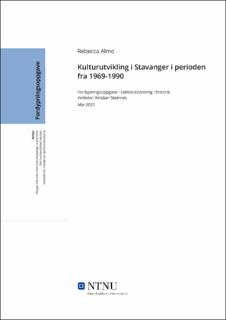| dc.contributor.advisor | Steinnes, Kristian | |
| dc.contributor.author | Almo, Rebecca | |
| dc.date.accessioned | 2022-09-20T17:20:07Z | |
| dc.date.available | 2022-09-20T17:20:07Z | |
| dc.date.issued | 2022 | |
| dc.identifier | no.ntnu:inspera:109096858:20686993 | |
| dc.identifier.uri | https://hdl.handle.net/11250/3019876 | |
| dc.description.abstract | Denne oppgaven tar for seg kulturutviklingen i Stavanger i perioden fra 1969-1970. Stavanger går i denne perioden fra å være en misjon- og bedehusby over til å bli en internasjonal oljeby. Innledningsvis gir oppgaven en definisjonsavklaring av begrepene kultur og kulturpolitikk, før den ser nærmere på noen viktige strømninger i norsk kulturpolitikk i perioden fra 1940-1975. Sentralt i denne utviklingen står arbeiderbevegelsens kamp for å demokratisere kulturen, og 1970-tallets nye «utvidete» kulturbegrep blir introdusert. Basert på dette vil oppgaven ta for seg Stavanger Kommunes kulturplan fra 1969, som var en av de første av sin art i Norge. Denne kulturplanen viste til klare kulturdemokratiske strømninger, og er i dag kjent som et pionerarbeid når det kommer til bygging av bydelshus og lokale kulturarenaer i Norge. Det var dog ikke bare kulturpolitikken som var med på å påvirke kulturen i Stavanger i denne perioden. Stavanger ble etter hvert også norsk oljehovedstad, noe som førte med seg økt innflytting både fra inn-og utland. Byen ble urbanisert og den internasjonale påvirkningen vistes godt igjen i bybilde. I Stavanger Kommunes kulturplan fra 1982, ser en tydelig at oljeindustriens penger i form av økte skatteinntekter gir rom for kulturutvikling. Dette gjør også de private sponsoravtalene fra byens oljebedrifter. De store omveltningene i byen førte også med seg problemer, og en ser nye tendenser i byens uteliv. Skiftarbeid og økt alkoholkonsum var blant oljeindustriens skyggesider. | |
| dc.description.abstract | This thesis address the cultural development in Stavanger in the period from 1960-1970.
Stavanger enters this period as being a city of mission- and a town with houses of prayer to transition to and international oil town.
To begin with this thesis will start bee giving a clarification of the definition of the terms culture and cultural politics before it looks closer at some important tendencies in Norwegian cultural politics in the period from 1940-1975. Important at that time was the labor movements struggle to democratize the culture, and the new and extended concept of culture as introduced in 1970`s. Based on this, the thesis will look at the cultural plan of Stavanger from 1969, which again was one of the first of its kind in Norway at the time.
This cultural plan showed clear cultural democratic currents and is known today for having paved the way for the pioneering work regarding the building of town halls and the local cultural arenas in Norway. It was not only cultural politics that had a part in influencing the culture in Stavanger. Eventually Stavanger became Norway’s oil capitol, and with that came increased occupancy both from domestically and abroad. The city was urbanized, and the international impact was clearly visible in the cityscape as well. In the cultural plan from Stavanger from 1982, one can see that the money from the oil industry led to increased tax income made room for culture development. The same did the private sponsor deals form the private oil companies. The great upheavals in the city brought with it some problems as well which were seen in the city´s nightlife. Shift work and increased consume of alcohol were some of the downsides of the oil industries impact in Stavanger. | |
| dc.language | eng | |
| dc.publisher | NTNU | |
| dc.title | Kulturutvikling i Stavanger i perioden fra 1969-1990 | |
| dc.type | Bachelor thesis | |
